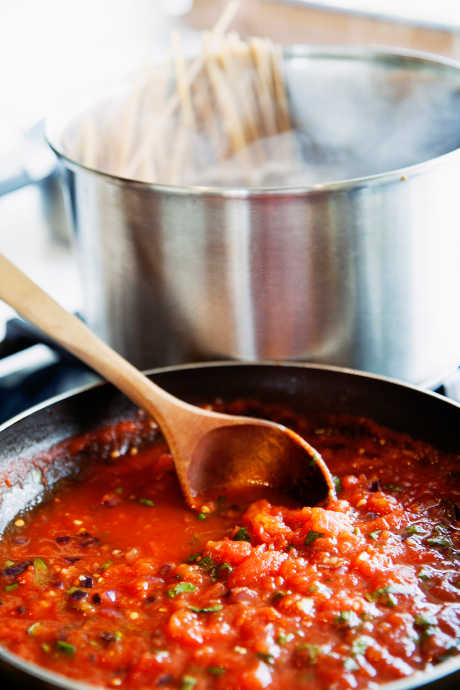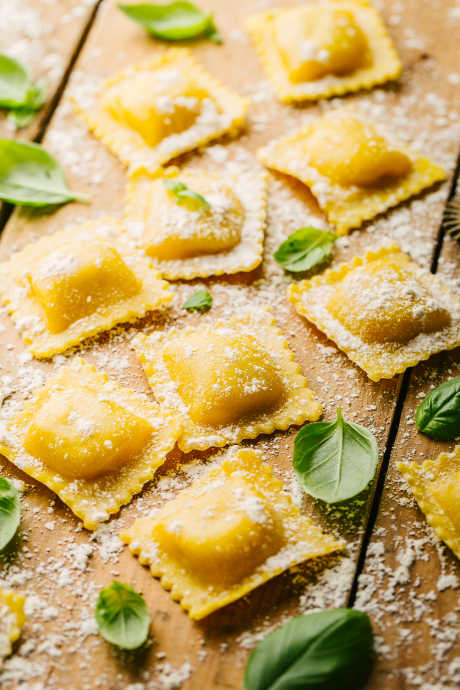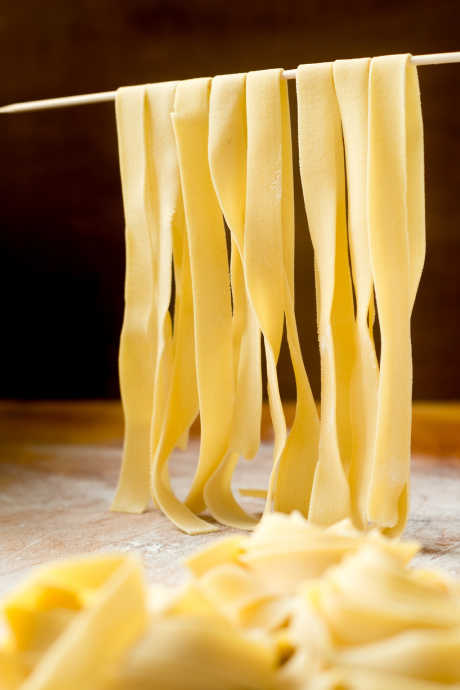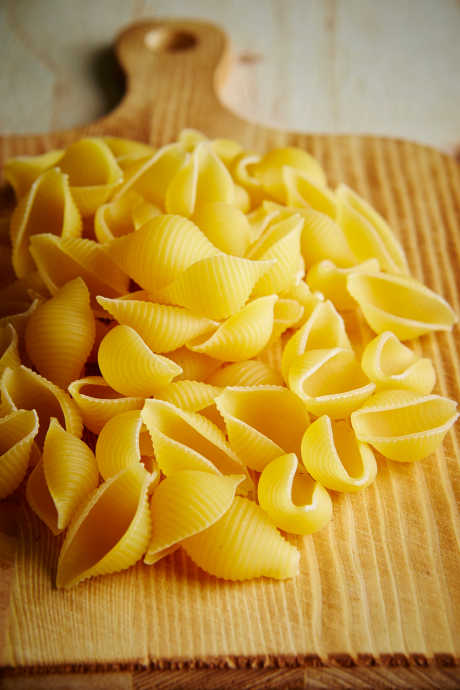14 Pasta Shapes to Pair With Your Favorite Sauces
Posted by Julie on Sep 18th 2019
How much do you know about pasta shapes? Did you know there’s a reason why certain sauces are typically paired with long, smooth noodles, while other sauces are served with short noodles full of ridges or indentations? While there may be elements of tradition, pasta combinations are usually based on what noodles serve as the best means of holding and carrying sauce and toppings.
Get ready to learn all about pasta shapes and the sauces that go well with each one. We bet you’ll be ready to carbo load after this post.
Which Comes First: Pasta or Sauce?
How do you decide what sort of pasta to serve? That depends on what sort of sauce you plan to make.
What sort of sauce should you make? That depends on what sort of pasta you have.
Sauce and pasta are inextricably linked because pasta is cut to go with particular sauces. Likewise, sauces are created to work with different pasta shapes and sizes. Pasta tastes the same no matter what shape and size the noodle may be. Fillings and sauces are what make the difference in taste.

Use these two key guidelines to help pair pasta varieties with sauces. First, Panera advises that “delicate noodles go well with a delicate sauce, while heartier noodles can stand up to a heartier sauce.” Second, Johnathan Adler (former executive chef in Brooklyn, now with Blue Apron) asserts “chunky sauce = short noodle, smooth sauce = long noodle.”
Then again, no one will break down your door and take away your dinner if you mix and match pastas and sauces based on your own personal preferences. These guidelines, and all the details to follow, are all up to your discretion.
Types of Pasta and How to Serve Them
This list is not exhaustive. Even your local supermarket will carry varieties of pasta not listed here. If you visit a specialty grocery or a place like Eataly, we bet you’ll be astounded by how many different types of pasta are available. We’ve narrowed our list to those varieties you’re most likely to buy and prepare at home.
1. Tortellini
Tortellini is frequently available dried, frozen, and refrigerated. It’s shaped almost like a donut, with cheese, meat, or vegetable filling in between the layers of pasta. You can toss it with a light sauce, or add it to brothy soups. We prefer using frozen tortellini in soup. Save the refrigerated tortellini, which is usually more expensive, for serving with freshly-made pesto or tomato sauce.
2. Ravioli

Ravioli looks like a tiny pillow, either square or circular, with filling in the middle. Supermarket ravioli is often filled with cheese, meat, or vegetables, and you may find seafood ravioli on the menu at restaurants. We know ravioli is available in a can, but we’d encourage you to try the varieties that are fresh or frozen. While it doesn’t hold up to broth the way tortellini does, ravioli is delicious with simple sauces that complement the fillings. Greatist recommends brown butter and sage, and we agree.
3. Spaghetti
One of the two most well-known pasta noodles, spaghetti is a classic served with tomato sauce and meatballs. But it’s far more versatile than that. The shape and thickness of spaghetti makes it equally suited to meat sauce and marinara sauce, or simply tossed with garlic and oil. Try serving spaghetti with pesto and grilled chicken, or make spaghetti carbonara with egg, cheese, and bacon.
4. Linguine
Most people hear “linguine” and leap immediately to clam sauce or shrimp scampi. It’s true these dishes are two of the best-known ways to enjoy linguine. This pasta noodle is slightly more broad than spaghetti, and it’s flat instead of round. It pairs well with a variety of sauces too, from lighter ones like white wine and butter to heavier ones like clam sauce. Like spaghetti, you can also toss it with pesto or whip up linguine carbonara.
5. Fettuccine

Fettuccine is another pasta noodle that’s nearly synonymous with a dish: fettuccine Alfredo. Fettuccine is flat like linguine, but even wider. This sturdy noodle is a great match for thicker sauces like Alfredo. But you can also pair it with heavier meat sauces and top it with chunky proteins or vegetables.
6. Penne
Penne is fast becoming one of those well-known, possibly overused, pasta noodles like spaghetti and macaroni. That’s probably because it goes well with such a variety of sauces. Sauces cling to the ridged exterior and collect in the hollow of these pasta tubes, thanks in part to diagonal-shaped ends. You can also chop vegetables to roughly the same shape and size as penne, so you end up with pasta and toppings in each bite. Penne is also hearty enough to stand up to baking in casseroles.
7. Rigatoni
Rigatoni is similar to penne, with a tubular shape and ridged exterior. However, rigatoni tubes are larger and cut straight at both ends, rather than diagonal. These differences make it a good match for hearty sauces that are chunkier than penne can handle. Try rigatoni with Bolognese sauce or bake it in a casserole.
8. Conchiglie

Also known as shells, conchiglie comes in a variety of sizes, which can help you decide how to serve it. Large shells can be stuffed with ricotta and other fillings and then baked. Smaller shells are an ideal vehicle for meat sauces, and they’re a great choice for mac and cheese. You can even add the tiniest shells to soup; they combine well with peas, diced carrots, and other small ingredients.
9. Macaroni
Macaroni may be the most common pasta noodle of all, and it’s universally known thanks to the kid-favorite dish, mac and cheese. You’ll also find macaroni in other pasta salads and casseroles. These tiny curved tubes -- or “elbows” -- are perceived as unsophisticated, but they are undeniably kid-friendly.
10. Ziti
Baked ziti is a classic Italian family meal. These smooth tube-shaped noodles go well with cheese sauce, whether you bake them or not. The sauce won’t cling to the outside, the way it does with rigatoni and penne, but it oozes into the center of each noodle.
11. Farfalle

While farfalle is also known as “bowtie” pasta, the word farfalle means butterfly. These bite-sized noodles go well with other bite-sized ingredients like meat and vegetables. They’re also hearty enough to carry tomato sauces and cream sauces, but you can toss them with pesto too. Farfalle is a good choice for cold pasta salads too.
12. Fusilli
Another favorite for pasta salads, fusilli is full of nooks and crannies perfect for holding creamy sauces. The size and shape of this noodle also makes it a good match with meat and vegetable-based sauces.
13. Orecchiette
“Orecchiette” means little ears in Italian, and this small round pasta noodle has an indentation that helps hold sauce. They’re often used in pasta dishes with peas, and they pair well with other diced vegetables too, whether in a hot pasta dish or in a soup or stew.
14. Orzo
Tiny orzo looks similar to rice, but it’s actually pasta. It goes well in pasta salads, but it’s also a hearty addition to soup or stew. Add as much or as little as you like.

